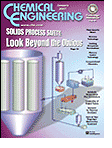Friday, February 27, 2009
Display problem ? Click HERE
Recommended :
- Subscribe FREE - Chemical Engineering
- Tips on Succession in FREE Subscription
 Steam is one of the most commonly use medium to transfer energy from one point another point, room and system heating, power generation, cleaning, etc. Steam also can be used to assist combustion as discussed in "Steam in FIRE...". Steam is clean, easy to manage, predictable properties and engineer is "understand" behavior of steam after few century of experiences.
Steam is one of the most commonly use medium to transfer energy from one point another point, room and system heating, power generation, cleaning, etc. Steam also can be used to assist combustion as discussed in "Steam in FIRE...". Steam is clean, easy to manage, predictable properties and engineer is "understand" behavior of steam after few century of experiences.
Steam once give it energy for process fluid heating, conversion to power energy via steam turbine, etc, it will probably form condensate and return to boiler for steam regeneration. Entire heat input, steam generation, heat transfer, condensate formation and finally return back to boiler again form a complete steam-condensate loop. The steam-condensate balance may be conducted using process simulator such as HYSYS, Pro-II, etc. Manual balance may be conducted as in discussed in "Conduct Steam-Water Balance MANUALLY using Water97_v13". Besides there are plenty of useful tools and guideline as listed in "Steam - Condensate Useful Links...". For those new subscriber, check it out.
This post would like to bring to you a very great "movie" about steam asset management, presented by Armstrong. The discussion includes :
To read FAQ about this presentation, click here.
Related Topic
- Subscribe FREE - Chemical Engineering
- Tips on Succession in FREE Subscription
Steam once give it energy for process fluid heating, conversion to power energy via steam turbine, etc, it will probably form condensate and return to boiler for steam regeneration. Entire heat input, steam generation, heat transfer, condensate formation and finally return back to boiler again form a complete steam-condensate loop. The steam-condensate balance may be conducted using process simulator such as HYSYS, Pro-II, etc. Manual balance may be conducted as in discussed in "Conduct Steam-Water Balance MANUALLY using Water97_v13". Besides there are plenty of useful tools and guideline as listed in "Steam - Condensate Useful Links...". For those new subscriber, check it out.
This post would like to bring to you a very great "movie" about steam asset management, presented by Armstrong. The discussion includes :
- Becoming "trap active" with steam trap survey
- Web based data management
- Common global reporting platform
- Steam trap diagnosis tools
- Real time information integration
To read FAQ about this presentation, click here.
Related Topic
Labels: Steam

0 Comments:
Post a Comment
Let us know your opinion !!! You can use some HTML tags, such as <b>, <i>, <a>
Subscribe to Post Comments [Atom]
Home:
<< Home